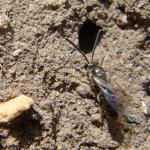Found principally in southern England from Cornwall to Kent, with other sites in Wales, Isles of Scilly and the Channel Islands. Scarce in northern England, Scotland and Ireland. Abroad, widespread in the western Palaearctic, east to Iran and north to Finland.
This species has not been regarded as scarce or threatened but in recent decades has declined significantly.
Mainly from sandy habitats including some coastal sites.
Late March to mid-September.
The species is considered to be a solitary mining bee. The female nests in steeply sloping, sandy soil, the bee digging a sinuous burrow which is reported to have linearly arranged cells at the end of branches (Pesenko et al. 2000).
Visits a wide range of plant families for nectar.
Reported to be the host of the cleptoparasitic bees Sphecodes crassus, S. geoffrellus, S. miniatus and Nomada sheppardana (Westrich, 1989).
2009


